
Matara is a major city in Sri Lanka, on the southern coast of Southern Province. It is the second largest city in Southern Province. It is 160 km (99 mi) from Colombo. It is a major commercial hub, and it is the administrative capital and largest city of Matara District.

Pettah is a neighbourhood in Colombo, Sri Lanka located east of the city centre Fort, and behind the Colombo Port. The Pettah neighborhood is famous for the Pettah Market, a series of open air bazaars and markets. It is one of Sri Lanka's busiest commercial areas, where a huge number of wholesale and retail shops, buildings, commercial institutions and other organisations are located.
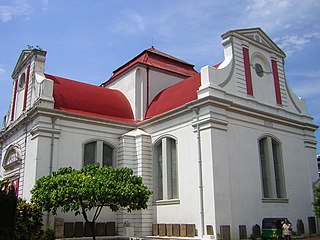
Kotahena is a suburb of Colombo, Sri Lanka, and is known as Colombo 13.
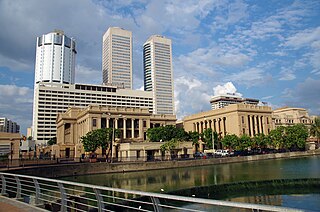
Fort (Colombo) (Sinhala: කොටුව; Tamil: கோட்டை) is the central business district of Colombo in Sri Lanka. It is the financial district of Colombo and the location of the Colombo Stock Exchange (CSE) and the World Trade Centre of Colombo from which the CSE operates. It is also the location of the Bank of Ceylon headquarters. Along the foreshore of the Fort area is the Galle Face Green Promenade, built in 1859 under the governance of Sir Henry George Ward, the Governor of Ceylon (Sri Lanka) during British colonial era. Fort is also home to the General Post Office, hotels, government departments and offices.
The Dutch Burghers are an ethnic group in Sri Lanka, of mixed Dutch, Portuguese Burgher and Sri Lankan descent. However, they are a different community when compared with Portuguese Burghers. Originally an entirely Protestant community, many Burghers today remain Christian but belong to a variety of denominations. The Dutch Burghers of Sri Lanka speak English and the local languages Sinhala and Tamil.
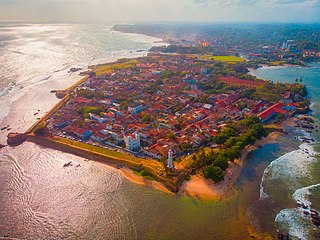
Galle Fort, in the Bay of Galle on the southwest coast of Sri Lanka, was built first in 1588 by the Portuguese, then extensively fortified by the Dutch during the 17th century from 1649 onwards. It is a historical, archaeological and architectural heritage monument, which even after more than 432 years maintains a polished appearance, due to extensive reconstruction work done by the Archaeological Department of Sri Lanka.

The Christian Reformed Church of Sri Lanka is the oldest Protestant church on the island.

Iman Willem Falck was a Dutch colonial governor who served as the 32nd Governor of Zeylan during the Dutch period in Ceylon. He was appointed on 7 August 1765 and was Governor until 5 February 1785. He was succeeded by Edward Hughes.

Wolvendaal Church is located in Pettah, a neighbourhood of Colombo. It is one of the most important Dutch Colonial era buildings in Sri Lanka, and is one of the oldest Protestant churches still in use in the country.
The Matara Fort was built in 1560 by the Portuguese and was substantially re-built by the Dutch in 1640, following the capture of Galle. The fort, which consists of a large stone rampart, occupies the promontory, which separates the Niwala Ganga (River) lagoon and the ocean.

The Groote Kerk or Dutch Reformed Church is located within the Galle fort in Galle, Sri Lanka and is situated near the entrance to the fort. The church was built by the Dutch in 1755 and is one of the oldest Protestant churches still in use in the country.
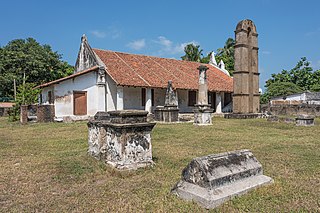
The Dutch Reformed Church is located between the Dutch fort and the village of Kalpitiya. The church was built by the Dutch in 1706 and is a smaller version of the church in the Matara fort. It is one of the oldest Protestant churches in the country.
Peter Daniel Anthonisz was a Burgher doctor who was the first Ceylonese to obtain an M.R.C.P. and F.R.C.S. He was also the inaugural president of the Ceylon Branch of the British Medical Association and a member of the Legislative Council for nine years.
John Leonard Kalenberg van Dort, commonly known as J. L. K. van Dort, was a 19th-century Ceylonese artist of Dutch Burgher descent.
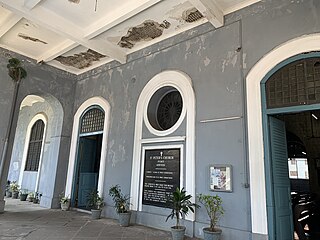
St. Peter's Church is one of the oldest continuously functioning churches in Colombo, Sri Lanka. It is located on Church Street in Colombo Fort, on the northern side of the Grand Oriental Hotel.

Kruys Church or Kruys Kerk is located within the Jaffna fort in Jaffna, Sri Lanka and is situated near the entrance to the fort. The church was built by the Dutch in 1706 and was one of the oldest Protestant churches in the country.
George Alfred Henry Wille was a Ceylonese proctor, notary public, journalist and politician.
Lionel Frederick Lee, served as the Mayor of Colombo in 1887 and Treasurer of Ceylon in 1899.
John Frederick Giffening was a Ceylonese proctor, public notary and politician.


















